This is a quick and easy recipe for pork siomai (shumai). This is the recipe that I refer to most of the time because it is simple and straightforward. It also allows me to enjoy my favorite siomai version in 30 minutes or less.
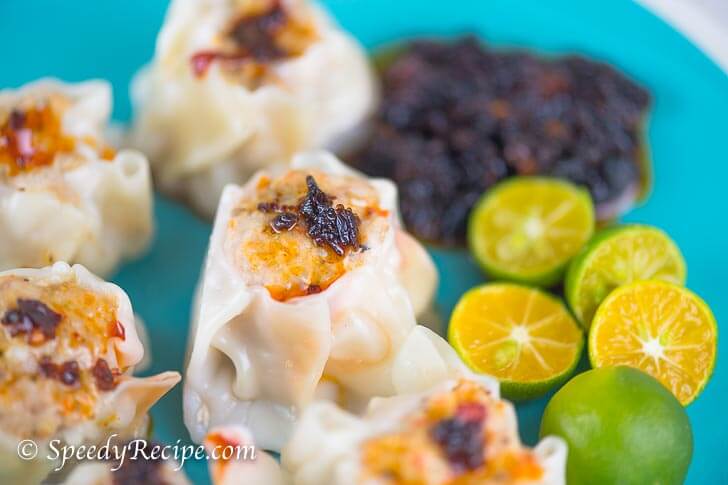
If siomai or shumai is something new to you, allow me to talk about it a little bit first before starting with the tutorial on how to make one.
Shumai is a type of Chinese dumpling. It can be made from different types of meat and vegetables (with the addition of seasonings and spices). The ingredients are mixed altogether and secured in a wrapper.
The Philippines
This recipe is a version of Siomai in the Philippines. It uses pork, a little bit of shrimp, along with egg and vegetables. The egg serves as the binder with the main function of holding all the ingredients together. It also prevents the mixture from crumbling. Siomai is usually cooked by steam, or through a method known as steaming. It is best eaten with a dip composed of soy sauce and calamansi and a spoonful of spicy chili garlic paste.
I made this over the weekend. While Dey and I were out enjoying the nice weather, we decided to visit a newly opened Filipino supermarket in Chicago. I heard that the Jollibee and Red Ribbon branches within the property just opened too. By the way, this is a Filipino fast food chain and bake shop respectively. The line was not that long. I was able to place my order within 15 minutes. However, it was quite unfortunate to wait around 40 minutes for our order to be completed, so I decided to go around the supermarket to check for hard to find ingredients. Sure enough, there was fresh calamansi (calamondin) and some fresh malunggay. Both these ingredients can rarely be seen fresh or unfrozen in this part of the world. I thought of making siomai right away (and planned to feature it in this blog); while the malunggay is intended for the different chicken tinola dishes that I will be featuring over at Panlasang Pinoy. The long wait for our order turned out to be a good thing.
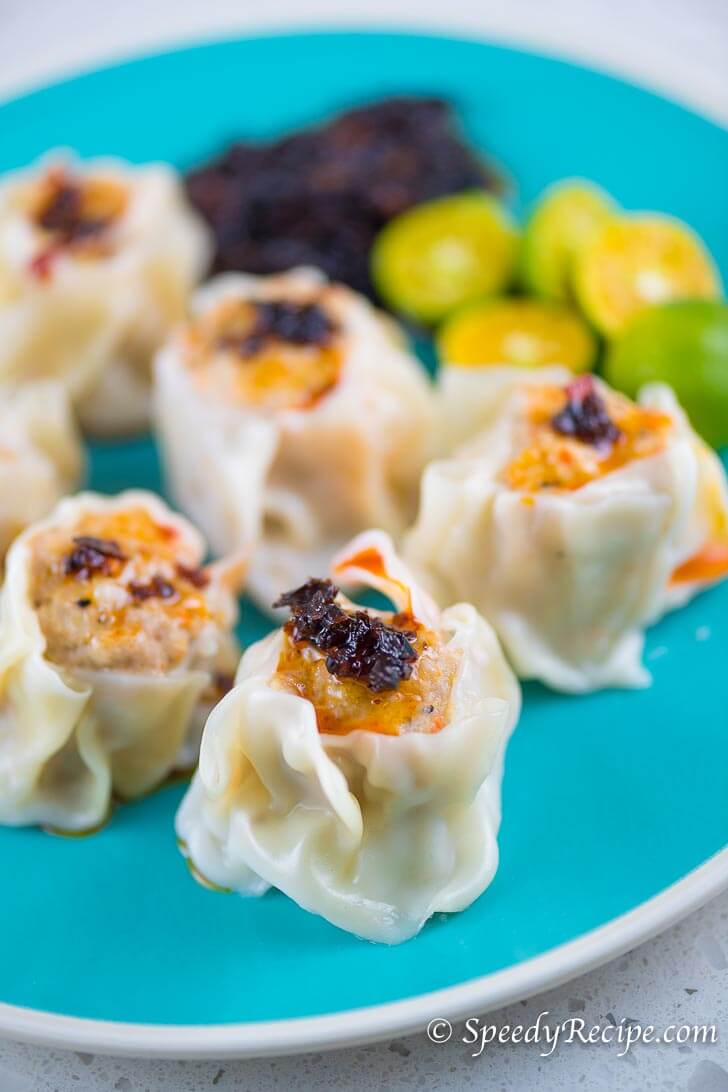
How to Make Pork Siomai (Shumai)
It might look complicated, but siomai is easy to make. If you are learning how to cook and would like to try easy recipes, go for this. All that we need to do is to make sure that all the ingredients ready (this means that meats and veggies are minced and cut properly), mix them all together, and wrap in a wonton wrapper. Steam it quickly and then it’s ready to eat. See the recipe below for the steps.
But what if you cannot finish these 6 warm, tasty servings of Pork Siomai at once? You must also be wondering how to keep it fresh and good to eat for longer. First, let’s look at how to deal with storage for siomai that we’ve already steamed.
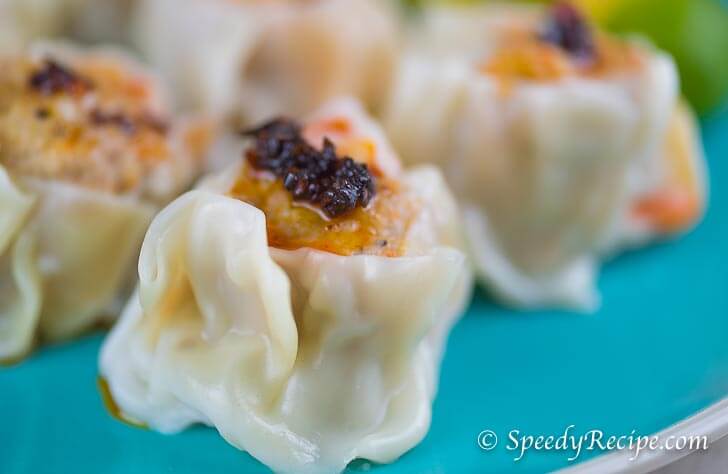
How to store Pork Siomai:
It’s quite convenient to already have your siomai cooked before setting it aside so that when you’re in the mood to chow down on it, it will take a very quick step of reheating. For this, you can take a baking sheet, and put parchment paper on top of it. Sprinkle in a bit of cornstarch or flour on top. Then you can place your pieces of siomai on top. Make sure you separate them by about an inch each.
Then put these in airtight containers. After that, you can toss this in the freezer. By freezing our delightful dish, we are able to extend its shelf life to a maximum of three months! Now what about uncooked Pork Siomai?
We will use very similar steps for this one. Just dust the bottom of your baking tray, as well as the sides with some flour. And then put your raw siomai there, making sure there is also an inch of a gap between them.
Now we must take this to the freezer, and keep them there for a good 2 to 3 hours. And then let’s put them inside a sealed container, or a freezer bag. Toss this back in the freezer, and this should be good for about a month. An important thing to note as well is that you should not simply refrigerate your uncooked siomai because this can make them soggy.
Going back to our frozen cooked siomai, let’s learn how to reheat this for eating once we’re ready to serve it again!
How to reheat Pork Siomai:
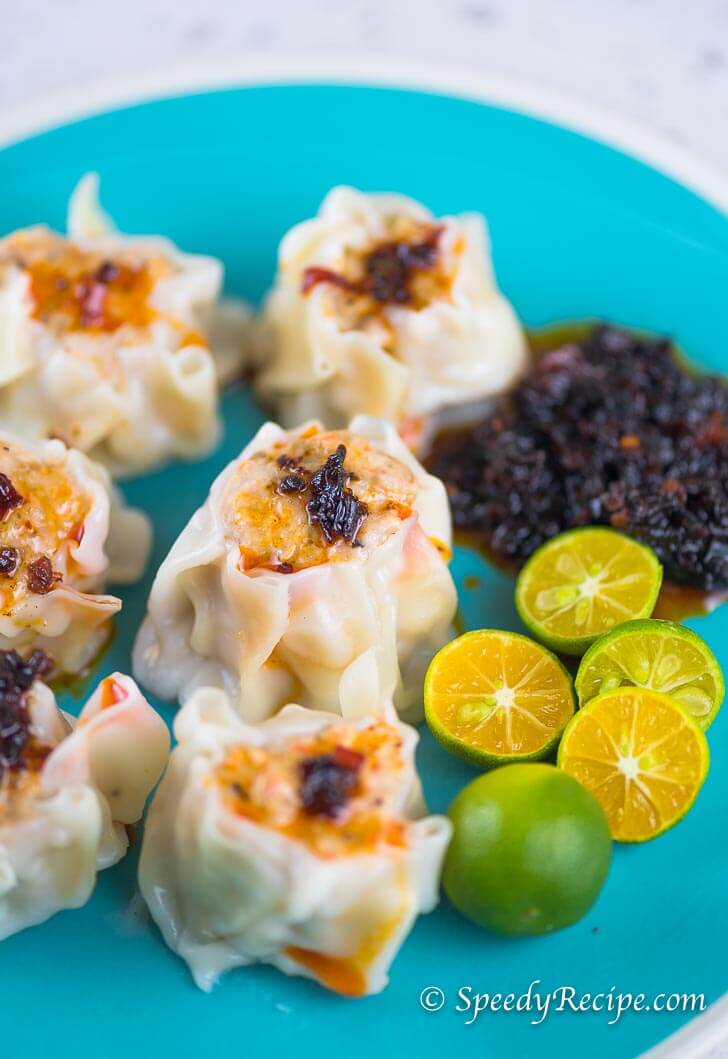
You can begin by taking out your siomai, and setting your heat to high. Then you can steam this for 2 to 3 minutes. After that, you’re done! There is another option, which would be great if you prefer fried siomai. Use medium heat to deep fry or pan-fry your siomai. Once it turns to a nice, golden color, or it is cooked as much as you prefer it to be, simply transfer this to a serving plate. You could also take out the cooking oil by using a paper towel.
Now what about trying other sorts of dumpling dishes for your next gathering? Here are a couple of other recipes you may want to take a look at.
More dumpling recipes to learn how to make:
Filipino Lumpiang Shanghai
Who can say no to a delicious, savory plate of Filipino Lumpiang Shanghai? This dish is a staple in more celebrations back home because it tends to be a crowd favorite. Bits of garlic, carrots, and of course, ground pork, truly bring life to our crunchy classic. To make for an even more scrumptious dish, we have seasonings like sesame oil and ground black pepper.
I also love this recipe because once you have assembled your rolls of lumpia, the steps are pretty quick and simple! Just fry it and go! This makes it perfect for days of meal prep to be started the night before. You can just wake up, take your lumpia out of the fridge, and get it ready by frying. This recipe is also great for 6 servings so you will have plenty for either yourself in days ahead, or for your guests.
And if you are looking to pair this with something else, Filipino Lumpiang Shanghai tastes great with some rice noodles, pancit, or the classic white rice.
Dynamite Lumpia
Now if you love Filipino dumplings, but craving for something that packs an exciting punch, this is definitely the recipe for you. Dynamite Lumpia utilizes long green chili peppers to provide a load of savory and spicy flavor. Cheddar cheese also comes to play to provide a yummy, gooey taste from the inside of the lumpia.
This is also a pretty well-loved merienda dish, and can also work as pulutan or alongside some drinks. That is the beauty of Dynamite Lumpia— its powerful and delicious flavor works well flying solo. But it can also be an ulam or viand, and so feel free to have this with some rice.
As for dips, you can refer to the local favorite of banana ketchup to work as a flavorful duo with the spice. We can achieve a nice level of sweetness with our saltiness using this. But you can also get some soy sauce with calamansi, sriracha mayonnaise, as well as sweet and sour sauce. It would be nice to serve this with an array of different dips to choose from.
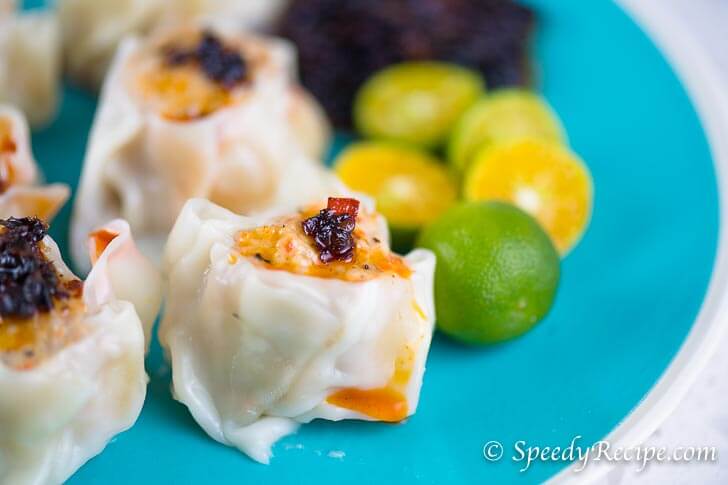
Have any questions about making some tasty Pork Siomai? Or perhaps any suggestions for new recipes? That’s what the comments section is for. Let me know your thoughts by commenting below!
Pork Siomai Recipe (Shumai)
Ingredients
- 1 1/2 lbs ground pork
- 6 shrimp
- 1/2 cup Jicama singkamas – optional
- 1 yellow onion
- 1 carrot
- 1/2 cup mushrooms
- 1 egg
- 1 1/2 tablespoons sesame oil
- 1/2 teaspoon ground black pepper
- 2 teaspoons salt
- 1 pack wonton wrapper shumai wrapper
Instructions
- Mince the carrot, onion, mushroom, and shrimp. Place all the minced ingredients in a large mixing bowl.
- Add the ground pork, sesame oil, salt, pepper, and egg. Mix until all the ingredients are well blended.
- Scoop 1 to 1 1/2 tablespoons of the shumai mixture. Put it in the middle of a Won ton wrapper. Secure while leaving the top open.
- Arrange the wrapped siomai into a steamer. Steam for 20 to 25 minutes.
- Serve with chili garlic paste and a dip of soy sauce and calamansi (or lime).


I love the recipes. Thank you so much I learned how to cook for my family especially for my mother. She really likes siomai. Big help for me. Thanks again.
Hi Chef Vanjo! Do u have a recipe for the chili garlic sauce?
i love the recipe
thank you so much
i like siomai @dumpling
I followed the recipe and ingredients, and perfect. The siomai is so delicious.
Hi ? after steaming the siomai, As i looked on it why it has hard part on top? I mean the wrapper. Why it didn’t become soft?
I think that the quality of the wrapper is the reason.